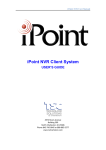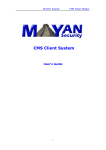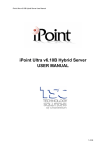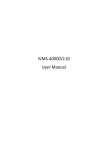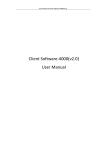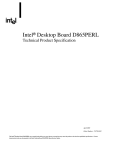Download iPoint Ultra v6.32 Client USER MANUAL
Transcript
iPoint Ultra v6.32 Client User Manual iPoint Ultra v6.32 Client USER MANUAL I iPoint Ultra v6.32 Client User Manual Content Chapter 1 Start up and Main interface........................... 8 1.1 Disk management ........................................................................ 8 1.2 Start up ........................................................................................ 8 1.3 Main interface.............................................................................. 9 1.3.1 Show tips ............................................................................................9 1.3.2 Screen menu .................................................................................... 10 1.3.3 Interface description ........................................................................11 1.3.4 System Menu ................................................................................... 12 1.3.5 Connection group............................................................................ 15 1.3.6 Connection list ................................................................................ 15 1.3.7 PTZ control panel ........................................................................... 16 1.3.8 Color/Audio adjustment.................................................................. 18 Chapter 2 Local setup................................................... 19 2.1 System setup.............................................................................. 19 2.1.1 System setup .................................................................................... 19 2.1.2 Add/Modify server........................................................................... 23 2.2 Group setup ............................................................................... 24 2.3 Record setup .............................................................................. 26 2.4 Right setup................................................................................. 27 2.4.1 User setup ....................................................................................... 28 II iPoint Ultra v6.32 Client User Manual 2.4.2 Right setup ...................................................................................... 28 Chapter 3 Local search................................................. 30 3.1 Main interface............................................................................ 30 3.2 Partition mode ........................................................................... 30 3.3 Playback .................................................................................... 30 3.3.1 Select date ....................................................................................... 30 3.3.2 Select camera .................................................................................. 31 3.3.3 Select file......................................................................................... 31 3.4 Play file and related operations ................................................. 33 3.4.1 Play files.......................................................................................... 33 3.4.2 Capture pictures.............................................................................. 33 3.4.3 Search captured pictures................................................................. 34 3.5 Create clip file ........................................................................... 35 3.5.1 Create file clip................................................................................. 35 3.5.2 Backup by Time ............................................................................... 37 3.5.3 View backup file .............................................................................. 39 3.5.4 Burn CD .......................................................................................... 39 Chapter 4 Remote setup............................................... 41 4.1 For PC-DVR.............................................................................. 41 4.2 For DVS and EM-DVR ............................................................. 41 4.2.1 Functional buttons .......................................................................... 41 III iPoint Ultra v6.32 Client User Manual 4.2.2 Server setup..................................................................................... 42 4.2.3 Channel setup ................................................................................. 43 4.2.4 PTZ control ..................................................................................... 45 4.2.5 Sensor setup .................................................................................... 48 4.2.6 Alarm setup ..................................................................................... 50 Chapter 5 Remote Search ............................................ 52 5.1 For PC-DVR.............................................................................. 52 5.2 For EM-DVR............................................................................. 53 Chapter 6 IE client......................................................... 55 6.1 Functions of IE Client ............................................................... 55 6.2 Main interface............................................................................ 55 6.2.1 Connect record................................................................................ 56 6.2.2 Partition mode ................................................................................ 56 6.2.3 PTZ Control .................................................................................... 56 6.2.4 Local & Remote search................................................................... 56 6.2.5 Quit program................................................................................... 56 6.3 Local search............................................................................... 56 6.4 Remote search ........................................................................... 58 IV NVR Client Manual Introductions: Thank you for purchasing our NVR client system. This NVR client system can connect to the PC-DVR (NV DVR system), EM-DVR and DVS. It can also set them and search their recording data remotely. In addition, it can view server’s log (only for PC-DVR) from long-distances, and support IE browser connect DVR client. 5 NVR Client Manual Important Information: For optimal performance of your system, it is important to follow these recommendations. 1. We recommend that you divide your hard disk into two partitions (E.g. C and D). The first partition is used to install Windows OS and system software, the other for storing record files. 2. Please use appropriate motherboard and display card. Contact your dealers or our support engineers if you have questions. 6 NVR Client Manual Recommended System Requirements Chipset: Intel, 875PE, 915P, 945P, 965P Motherboard: Intel: D915/945PCY, D865PERL Asus: P4P800SE, P5P800 MSI: 865PE Neo2-F, 915/925/945; Gigabit: GA-865GME, GA-945PL-G etc Video Card: ATI Rodeon 9250 128MB, ATI Radeon 9550 128MB, ATI X500, X550, X700 etc; Processor: Intel Pentium 4 2.4GHz or better Memory: 512MB minimum 7 NVR Client Manual Chapter1 Start up and Main interface 1.1 Disk management After installing NVR Client, user must assign space for recording. Otherwise, the software won’t record normally. The system will run the disk management automatically before user runs NVR Client the first time. Also, user can run disk manager to assign space. For details, please refer to the particular manual in DVR server manual. 1.2 Start up After installing the NVR Client software, a shortcut icon will be shown on the user’s desktop. Double click to run NVR Client software, the main interface will appear as the follows: 8 NVR Client Manual 1.3 Main interface 1.3.1 Show tips 1. When the mouse moves close to or stops above a button, a text tip will be shown to interpret its function. 2. Zoom in/out video image: Left-Double-Click a camera window to zoom in/out video image. 3. Recording status: --The system is recording continuously. -- The system is recording manually. -- The system is recording in motion detection alarm. -- The system is recording in event alarm. 9 NVR Client Manual 1.3.2 Screen menu Normally, user can press TAB key or Page Down (select next camera window) and Page UP (select previous camera window) key on keyboard to select a window. Users can Single-Right-Click image area (PC-DVR camera windows and IP camera windows) to popup the screen menu as below: 1. Full screen display - single-right-click to change the display mode to full screen mode, click again to turn back. 2. Instant playback - if you have set “Instant playback max time” in the local setup, then you can use this shortcut function. 3. End playback - to end playback. 4. Image quality, Frame rate, Resolution - for the sub-stream of PCDVR, you can adjust the Image quality, Frame rate and Resolution. This function is only available to PC-DVR that enabled sub stream in camera setup. 5. IP Video zoom in - zoom in IP video. 6. Switch to sub stream - can be the main / sub-channel. If user chooses the sub-channel, the images transfer poorly. 7. PC DVR Motion setup - Enter the motion setup remotely. This is only available for PC-DVR. 8. Device abnormity message - When the server is abnormally shut down and restarted, a message will automatically appear. To review the details, view the remote log. Note: 1) You can operate these functions after corresponding the settings in camera setup of the DVR. 2) Show prompt - When the mouse moves close to or stops over a button, the button function text prompt will be show immediately. 10 NVR Client Manual 1.3.3 Interface description 1. Partition mode Press button to set display mode. There are many types of partitions, including 1,4,6,9,13,16,20,25,28,33,36,40,49,64 partitions. Select the partition according to your needs. 2. Image capture Press button to save a still image of a selected camera. User can then review and print the image. 3. Manual record switch Press button to manually record to any camera. User must press the icon again for the recording to stop. 4. Information panel Date, time and display window information panel Information - Shows day of the week, current date, current time, and the percentage of CPU usage, the current selected window, and the current linkage in this window. 5. System lock After you check “use password management” in Right setup, press button to lock system. Lock keyboard and mouse to prevent unauthorized user to operate NVR Client system. Left-Single-Click this button to acquire the operation rights by entering the user and password. Default user ID is “admin”, no password. 6. Setting 11 NVR Client Manual Press button to enter Local setup submenu. In this menu, user can set system and related parameters. 7. Playback Click button in main interface to enter Remote playback interface. 8. Minimize button Press button to minimize the main window. 9. Exit program Press button to exit program. After clicking this button, a dialog will be displayed. Click “OK” to quit NVR system. 1.3.4 System Menu 12 NVR Client Manual 1. Remote Chat Press Remote Chat to initiate voice chatting. Click to have remote chat with the connected server. A sound card on each PC must be used for remote chat to work properly. Select a server from drop-down list to initiate remote chat. If connected successfully, an icon tip will prompt. . 2. View Remote log Press button to search logs from a server that user is connected. It’s preferred that no one is logged on the server end. User should now be able to view information from the server. Note: 13 NVR Client Manual Remote log is only available to PC-DVR. 3. View Local log The local system log keeps a record of system events such as local operation, local prompt, local system alarm and DVR device alarm according to time and date. Users can search the log by date, time and system parameters. When there is a motion alarm triggered, user can view its recording on the top right of this interface. User should confirm enabled “write log while alarm” in local system setup first. If the motion alarm lasts only for a short period, there may be no picture recording in the system log. 4. Local Playback Select Local Playback to enter Local Playback submenu. 14 NVR Client Manual 5. Remote setup Select Remote Setup to enter Remote setup submenu. In this menu, User can set the server’s parameters remotely. 6. Backup System parameters Backup the system parameters to the select path. 7. Import System parameters Import system parameters form the save path. 1.3.5 Connection group Press to enter connection group setup. This panel displays the information of groups and cameras. There are 18 preset groups the user can choose from. There are 64 to connect all of them and click windows and user can also click to disconnect all. The shade of icon will show the status of window: Window 1 disconnects Window 2 connects 1.3.6 Connection list Press button to show all the equipment you have added in this client. 15 NVR Client Manual Double click a camera and it will connect in a selected window. 1.3.7 PTZ control panel Press button to control the PTZ cameras. 16 NVR Client Manual 1. PTZ speed setup Press and drag the slider bar to adjust the speed of the PTZ camera. 2. Relay (On/Off) Controls the PTZ cameras internal relay (relay1) or the decoder’s relay (relay 1). Used to turn on a light or control an access gate. 3. Wiper (On/Off) If using the PTZ cameras corresponding wiper control relay, this toggles the relay/wiper on and off. 4. Zoom + / Zoom – Controls the zoom function of the PTZ cameras. 5. Focus + / Focus – Overrides the auto-focus setting of the PTZ camera, adjust to focus the image. 6. Iris + / Iris – Overrides the PTZ cameras auto-iris to brighten or darken the image. 7. Preset Call Press button to operate the speed dome. Only Preset Call is available. User should set the preset remotely first. 8. Control PTZ via video window 17 NVR Client Manual Pressing and dragging the mouse to the corresponding area can control the PTZ when there is a decoder. 1.3.8 Color/Audio adjustment Press button to enter Color/Audio Adjust Panel-Slider adjustments for the video image and recording volume of the selected tile. This also affects the live view of the video images. Press the first button and drag to adjust the brightness of the image that . you selected. Resume its default value by pressing Press the second button and drag it to adjust the contrast of the image that you selected. Resume its default value by pressing . Press the third button and drag it to adjust the hue of the image that you selected. Resume its default value by pressing . Press the fourth button and drag it to adjust the saturation of the image that you selected. Resume its default value by pressing . Press the fifth button to switch sound of the audio that is related to the image you selected. Drag the slider bar to adjust the volume. 18 NVR Client Manual Chapter2 Local setup 2.1 System setup Click button to enter local setup. 2.1.1 System setup 【Max. Record channels】Set the max record channels, the max number is 64. See the example below for 10 channels: 19 NVR Client Manual Then you can set the windows1-windowns10 in Record Set. 【Display Resolution】Select the display resolution for NVR. User can choose 20 NVR Client Manual from "Auto, 1024*768, 1280*1024, 1280*768, 1440*900, 1680*1050 and 1920*1080". When you select "auto", the software will automatically adjust its resolution with the resolution of the screen. 【Network Listen port】The alarm port to connect the client. Set in server. Restart NVR Client software. 【Web Listen port】The IE client connect port. Restart NVR Client software. 【Use electronic map】Select disable or enable to use the electronic map. At the same time, choose the mode from stretched and extended. Please refer to E-map manual for details. 【Connect server while alarm】 Enable - If there is an alarm on the DVR server end, the client will connect to the DVR server. 【 Data stream Auto adjust 】 1,1-4,1-6,1-9,1-13,1-16View->Main Stream, when you select one, the view should be less than what you choose in main stream. 【Write log while alarm】Select whether system writes alarm information log or not. There will be alarm information and corresponding recordings in local system log when you select enable. 【Default Connect Stream Type】Select the stream type as default. 【Auto Reconnect Time Interval】If you select the “Auto Reconnect Time Interval” function, and the software is disconnected, the software will reconnect automatically. 【Instant playback max time】Set the instant playback maximum time or disable the function. If you select “180sec” then user can use “Instant playback” in the main interface. See example below: 【Matrix card work mode】If using a matrix and decode card, select work mode from D1 decode mode or CIF decode mode to set it. Note: Each NV4002MD card can decode 2 channels D1 or 4 channels CIF. Each NV4004MD card can decode 4 channels D1 or 8 channels CIF. 21 NVR Client Manual Decoder will send out corresponding number channels from the first window in sequence. User can set each output port individually. 【TV output port】Select decoder card output port. 【TV output View Mode】Set the split mode for selected port. 【Window index of TV port】Select the index for each split window. For example: This icon has four windows: window1, window2, window3, window4. 【Decode channel Index in window】 Select window index for the selected window. Each window can only select one decode channel. The number of decode channels will be showed automatically according to the channels of the decode card. For example, if there is one NV4004MD card, it will show the 8 decode channel. If there are two NV4004MD cards, it will show the 16 decode channel. If there is one 4002MD card, there are only 4 decode channels. 22 NVR Client Manual This figure above shows the decode channels have been selected. Note: If using the “CIF decode mode”, and there isn’t preview video appearing in the NVR client main interface, the reason is that the resolution set too high in DVR Server end. For example: D1. (Please restart NVR Client software after this item is setup). 【Software Start Auto Connect】Select the group set in Group setup to be connected when the program starts. When you select “Disable”, Client will not connect to the camera automatically. 【Software Start Auto Connect】Select the group set in Group setup to be connected when the program starts. When you select “Disable”, Client will not connect to the camera automatically. 【Auto Reconnect time interval】Select whether the client reconnects when the connection is interrupted and the time interval. If you select “Disable”, and the connection is interrupted, the program will not reconnect automatically. If user selected the “Auto Reconnect Time Interval” function, and the software is disconnected, the software will reconnect automatically. 【Keyboard use COM port】Select a COM port for the keyboard to connect. Please refer to Keyboard Manual for details. 【Grab picture save to】Fill in the save path that you want your captured pictures to be saved to. 【Language】Show the current language. You can change when there is another language pack. 2.1.2 Add/Modify server button to add a new server in this 【Add connect server】Press system. When user is adding a new server, if there are some problems, ie: network issues or the Server is not running, the addition will fail. 【Server Name】Input a name that is easy to identify. 【Device Type】Select device type to add. This client system can connect PC-DVR (NV DVR Server system), DVS and EM-DVR. The system supports 23 NVR Client Manual the following types of device: PC DVR, NV Series IP, DG Series EMDVR, Sony IP Camera, ACTi IP Camera and Huviron IP Camera. 【IP Address】Set IP address of server host. 【Connect Port】Set the port which connects to DVR Server. 【Login user ID/Login Pass】 When the client wants to visit the server and the server has rights management set up, a login is required and user ID and password will be checked. If the user has no right to visit that camera, the connection will be cut down automatically. If the function is not used, the ID and password will not be checked. 【If use DNS to get IP】Select whether to use DNS to get IP or not. If the server end is the dynamic IP address, user needs to use DNS to get the server’s IP. 【DNS Server IP】Set IP address of DNS server host. 【DNS Server Port】DNS server host’s port, which provides connection to DNS software. 【Modify server】Press button to modify server information, its interface is the same as Add Connected Server. button to delete a connected 【Delete connected server】Press server. 【Motion Alarm Play Wave File】Select the wave file which the motion alarm plays. 【Sensor Alarm Play Wave File】Select the wave file which the sensor alarm plays. Note: When you finish the setups you should save your changes by pressing SAVE button before you exit setup. 2.2 Group setup Click button to enter the following window 24 NVR Client Manual Choose a group from drop-down list “Select Setup Group”. There are 18 groups. In every group, you can set 64 connections. Also, user can select the partition for every group from the drop-down list “Partition Mode”. Then you can set group as follows: 【IP Address Alias】Select the server in which the camera will be selected to show. If it has no server in the drop-down list, you need to add server in the “Server IP” page. 【Camera】Select the camera of the server set in 【IP Address Alias】 to be connected. In one window, you can set one or more camera’s connection (). If more than one camera shows in one window, you can set cycle interval time. You can switch them by pressing button interface. 25 and in Main NVR Client Manual 【Frame Rate】There are three selections: Real-time, Auto and 1fps. Real-time: If this is selected, the server will send all compacted information to client. When the client gets this information, it will automatically play. However, this consumes a lot of CPU. If there is no information lost when compacting and sending, the playing will be real-time. Auto: The difference between real time and auto is that some data is cut before the client receives the information. It also consumes less CPU space. If you click any camera, the system will adjust frame rate back to Real Time automatically. 1fps: This means that the only one frame of information is sent to the client every second. It consumes little network and CPU space. If you click any camera, the system will adjust frame rate to real time automatically when there is enough network space. (NOTE: This selection is only effective on PC-DVR). 【Stream Type】Select the stream type main channel or sub channel for the current camera. 2.3 Record setup Click to enter the recorded setup interface. 26 NVR Client Manual 【Select Window】Select the window you want to set. 【Record type】Set the type of recordings, including Normal record, Sensor record, Motion record, Motion or Sensor record and Not record. You can set record type as follows: First, press the button type that you want to set. Then select the recording time by pressing the grid (delegate 30 minutes in a day) or left-click mouse and drag for an area. If the user wants to set the same recording status every half hour every day, user may double-click the upper left corner of the chart. When user finishes the setup, the grid will display the corresponding color of the recording type. Green: Normal Record. Red: Sensor Record. Blue: Motion Record. Yellow: Motion or Sensor Record. Gray: Not Record. 【Copy Record Plan to】Copy the setup to any other window or all windows. 2.4 Right setup Click button to set up user rights. 27 NVR Client Manual 2.4.1 User setup 【Add User/Del User】Click / icons to add /delete user for the Client. Afterwards, user can edit the information for the user to be added. 【Select User ID】Select a user that exists in the system to be modified from drop-down list. 【Use Password management】Select a solution to determine if enabled user password is valid. When you select enable, and user is logged in, a password is needed. 【User ID】When adding a new user to the system, input new a User ID in this box. 【Select User ID】this selection is unavailable. 【Password】Set new user and selected user’s password. 【Auth. Level】Select user type. When you select admin in【Select User ID】 this selection is unavailable. 【Confirm password】Confirm password again. 2.4.2 Right setup You can set user management in this window after you input user name and password. User will then have corresponding rights with that name. Choose a user and distribute corresponding rights. 28 NVR Client Manual After setting, click the button to save the information. 29 NVR Client Manual Chapter3 Local search 3.1 Main interface Select Local Playback to enter local search interface as below: 3.2 Partition mode Press button to select partition mode. There are 1, 4, 9 and 16 partition modes. In the server end, user can only connect to 16 channels simultaneously. When the connected channels exceeds the limit, the system will popup information to indicate. 3.3 Playback 3.3.1 Select date 30 NVR Client Manual Select one window (the 1st one in default), and then click button to show the date. The blue dates contain recorded data. The green date is the current date. The gray dates signify no data. Only those in blue can be selected and when they are selected, the camera window will appear automatically to show which cameras have recorded data. Click or to change month and year of search data. 3.3.2 Select camera After selecting date, the system will show the camera state of corresponding day, or click button to show the camera’s state of current day. The number button with navy blue means this channel has recorded data. By pressing the numerical panel, the DVR system will play back recorded data from the first file. 3.3.3 Select file After selecting the camera to play, the user can click 31 button to NVR Client Manual show all the files of this camera. By default, the system will play back video files from the first recording. In this screen you can change the file user wants to play by clicking. The camera list below the window will show the recorded data of the day user selected. Double-click one hour of that day and the system will play back data from the beginning of the hour via the window you selected. Press or button to see the recorded data of other cameras, Click any minute of that hour and the system will play back time via the window you select. The red bar of the minute’s list and hour list is the exact time which the system is playing back. Tips: Right click the picture to perform digital zoom function. Different colors show information of all cameras. User can view all kinds of recordings, time and length, according to recorded data. Note: When you check Filter by Server in Date Select panel, there will be a server list in Camera Select panel. Select one server to search recorded data. 32 NVR Client Manual Also, user can click button to show all the files of this camera. 3.4 Play file and related operations 3.4.1 Play files Press of the cameras. Press button to open all playback windows according to the order button to close all playback windows. Click this button to synchronize all playback channels time. Last frame, Start, Pause, Stop and Next frame. First frame of that day, Previous minute, Next minute and Last frame of that day. Image zooms out - Press this button, single-left click on an image. quarter of the image will be enlarged. Afterwards, single right click on the image and it will resume the normal. A Adjust the voice: click the button to clear the voice. Adjust playing speed: click the button to resume normal playing speed. Note: It is not suggested that multi-channel (more than 10 channels) record and playback continuously due to the large data files. Multi-channel searches in client and server are the same, except for their paths. In client, there are local and LAN searches. In LAN searches, the system searches through the recorded data in the local network. 3.4.2 Capture pictures 33 NVR Client Manual Click capture button to capture a displayed picture. When one is captured, a dialog will display the interface information and the user can change the file name. After you press confirmation, the system will save the picture in default path: System volume\Grab\search. Note: The size of the image is that of the playing window. 3.4.3 Search captured pictures Click to enter the search window. 1. Select pictures from directory and file list You can select a captured picture from the directory and file list in local disk. By default, the directory is: System volume\Grab\Search. After you selected the path, the file name will show in the top of the window. 34 NVR Client Manual 2. Related operations 1) After you edit the picture user can select the pathway. 2) Function buttons of picture disposal. 3) 4) 5) When the result of disposal is not good click it to the default. Print picture. When the image is wider than 400 pixels, it will print smaller. If it’s larger than 400 pixels, it will print bigger. When it’s bright, with the mouse moving, part of the picture will be enlarged. 6) Delete current file or delete all files. 3.5 Create clip file Click button. There are follow 4 items to select. 3.5.1 Create file clip Click Create file clip to create file clip. 35 NVR Client Manual 1. Select channel and path Select channel and path of the backup file. 2. File list and attribute Select a file and double-click it to play. Its attribute’s will display below the list, including begin time, end time, file size, resolution, frame rate, etc. 3. Play file and related operations (1). Play control Press and drag slider on 36 NVR Client Manual button to control the player time. (2). Beginning and stop time setup Press to set the beginning time and end time of the file. The file attributes on the left will show the size of the file. (3). Save file Press it to save the file from beginning to end. (4). Voice control Click to control voice, press it to clear voice. 3.5.2 Backup by Time Click Backup by time to backup by time. 1. Save Path 37 NVR Client Manual Select path for the backup file. User can backup recorded file to a CD. 2. Backup Camera Select the backup camera. User can select more than one camera at once. 3. Select begin/end time Select the backup files’ begin time and end time. 4. Unite File Select unite file to be enabled or disabled. If you selected disable, the recorded files will not unite. If you selected enabled, all recorded files will be united. User can also set the maximum value of the united file. 5. Backup File Max Value Set maximum value of the united file. If the file’s value is bigger than this value, it will be spit. You can check the file’s value use button to show its value. 6. Backup Data Size Shows the size of the backup file. If user backups recorded file to CD, the data size should not exceed more than 650M. Note: If user backs up recorded files to CD, the system disk volume’s (C volume in general) free space should not be less than twice the backup data size. Because the systems volume will be using buffer area when burning CD. For example, if the backup data size is 450M, the systems volume’s free space should be more than 900M. The process of burning CD: 1) Select CD-ROM as the backup path, and then select the camera and time. 2) Check the backup files’ value. 3) Back up the file to the temporary file in the last volume, double check the free space. Otherwise, write backup file to the second volume. 4) Write back up file to buffer. 5) Write CD. 6) Delete buffer and temporary file. 38 NVR Client Manual 3.5.3 View backup file Press to view backup files. Select channel and path of the backup file in local disk. 3.5.4 Burn CD Press button to burn CD. 39 NVR Client Manual ① ④ ② ③ Area 1: File directory. Area 2: File list. Area 3: The File directory and list of will be burned to CD. Icon 4: Create a new directory in area. : Add selected file from area to area. : Delete selected file from area. 【Burn CD drive】Selects CD-ROM driver. 【Volume label】 Sets the CD’s label. 【Total file size】Shows the size of all files that will be burned to CD. : When you finish your setup, click this button to write file to CD. 40 NVR Client Manual Chapter4 Remote setup 4.1 For PC-DVR Remote setup for PC-DVR is nearly the same as local setup in DVR. For details, please refer to our DVR User Manual. 4.2 For DVS and EM-DVR The remote setup interface of NV Series IP devices is below: For DG Series EM-DVR, the interfaces are not exactly the same as NV Series. Remote setup for DG Series EM-DVR includes Server, Channel, Record, PTZ, Sensor, Alarm and User. But the ways of setup are nearly the same. For details, please refer to our DG Series EM-DVR manual. 4.2.1 Functional buttons 41 NVR Client Manual There are 5 buttons in each page. They are Upgrade, Restart, Time adjustment, Save and Exit. The system can upgrade to the server remote. Click this button, and select the right file. Some settings will only come into effect after device reboots. Adjusts date and time of DVS or EMDVR. The new date and time will coordinate with NVR client computer. After setup is finished, click this button to save the setup. Exit setup. Remote setup for DVS includes Server, Channel, PTZ, Sensor and Alarm. 4.2.2 Server setup Press button to set server parameters remotely: In the server window, some blanks backgrounds are gray. Those parameters are read from the server and the user can’t modify them. Other blank cells, whose background is white, use can set them remotely. 【Server Name】Enter the name description for easy identification. This name delegates the server. If user uses DNS to get IP address, this address will be used. 42 NVR Client Manual 【IP configuration and related】 【Server IP】 These are network configurations. User can set LAN or Internet IP according to their needs. 【Port】 【Subnet Mask】 【Net Gate】 【Net Cable Type】 【If use PPPOE】 【PPPOE Login Name】 【PPPOE Login Pass】 If system uses PPPOE to connect with web, please select it and input the PPPOE login ID and password. 【User Pass 】Set the user password of DVS remotely. After that operation, you should change the Login Pass to corresponding value in Add / Modify server. Otherwise, user can’t connect the DVS correctly. 【DNS Server IP】If using DNS, input the DNS host IP address. 【Remote manage】 【Remote manage IP】 【Remote manage port】 Set the IP address and port of host server who will receive the messages uploaded from the server. 4.2.3 Channel setup Press button to set channel parameters. 43 NVR Client Manual This section contains the parameters to designate a name for every camera connected, to enable or disable, show LOGO and OSD, and to set display type of OSD & LOGO. As well as record resolution, record type, record quality and frame rate, etc. 【Camera】Select the camera to be set from the drop-down list. 【Camera Name】Enter a name description for easy identification. 【Frame Rate】Select the record rate of camera from drop-down list. 【Mainstream】【Sub Stream】Select Mainstream or Sub Stream for the current cameras. 【Resolution】Set the resolution at which the video files will be recorded. Choices are DCIF, CIF, QCIF, 2CIF and 4CIF. The higher the resolution, the more disk space needed. 【Stream Type】Select video and audio, or only video record. 【Image】Set the quality of the image to be recorded. Select from worst, worse, normal, good and best. 【Bit Rate Type】Select bit rate type from Variable Bit Rate (VBR) and Fixed Bit Rate (FBR) record: VBR range= Poorest, Poor, Medium, Good, Best. FBR range = 45 Megabytes/Hour to 400 Megabytes/Hour. 【Max Bit Rate】Select the maximum bit rate for Variable Bit Rate (VBR) recording. 【Show LOGO/ OSD/ Week】If checked, the system will show corresponding information on the screen. 【Position】Set the position of OSD or Logo by entering the X and Y 44 NVR Client Manual coordinates directly. 【OSD】Set the display attributes of the OSD & LOGO. There are four types of display modes: Clarity-Glitter, Clarity-Not Glitter, Not Clarity-Glitter and Not Clarity-Not Glitter. 【OSD Type】Select the type of OSD for the week. 【Privacy Mask】You can check this box to set the privacy mask on the image directly. User can also clear some privacy masks by pressing button. 【Record schedule】User can set recording schedule in following chart. Note: This recording schedule is only available to EM-DVR. There are 4 time segments every day. Every segment has a start time, end time and record type. The time segment is set in sequence; every segment can’t be overlapped, included or skipped with any other. 【Copy to】After finishing one channel, if user wants to set any other channel configurations the same as this camera, you can select a channel number from drop-down list and press button. Set the time to record. 4.2.4 PTZ control Press button to set PTZ. 45 NVR Client Manual In this screen, you can define the PTZ protocol and set the Preset Position as well as the plan to execute them automatically. 【Camera】Select the camera to be set from the drop-down list. 【Baud rate】Set baud rate, according to PTZ protocol, from the drop-down list. 【PTZ Protocol】Select the communication protocol for the PTZ camera from the drop-down list. 【Copy to】After finishing one channel, if you want to set any other channels configurations the same as this camera, you can select channel number from drop-down list, and press button. 【PTZ Address】Set the address of the decoder. This must match with the value of dipswitch in the PTZ. 【Speed】Set the speed of the PTZ. 【Preset position & schedule setup】Define preset position and set time to call preset position automatically. System can add and delete plan time. 46 NVR Client Manual 【Name】 Set the name for the current preset. 【Preset】 Set the preset number for the current camera Setup the preset by current configuration. Delete the finished Preset. Call the Preset if the Mode is Call preset. The mode is saved in preset and user should save the preset and shouldn’t call the preset. to “disable”. When there is no PTZ action, set Afterwards, the PTZ will come back to the home position. 47 NVR Client Manual 【Preset】User can add the preset into the Preset Schedule. 【Call Time】【Schedule List】Set the time of the preset. Tour Group Add the Preset cameras into the Tour Group and set the Stay Time for one tour group. 4.2.5 Sensor setup Press button to set sensor parameters. 48 NVR Client Manual 【Sensor NO】Select one sensor to be set. 【Sensor Name】Enter the name description of the sensor. 【Type】Select alarm type (sensor type) from “NO” (Normally Open) or “NC” (Normally Close). 【Policy】Select “Sensor Alarm Handling” first, the handling policies will be available as follows: On screen warning—Displays the alarm information on the monitor. Audio warning—Indicates the alarm with voice. Upload to center—Updates the alarm information to center. Trigger alarm out—Triggers alarm box to output the alarm. 【Trigger record camera】Set cameras to record, triggered by the alarm. You can select one or more channels. When there is alarm input, the cameras will be triggered to record (the record type of the channel is Alarm Record), and the monitor will switch to preview the cameras (warning on monitor is enabled). 【Preset】Set camera that will move to its one preset position when the alarm occurred. 【Schedule】Set alarm input precaution time first, then set time segment according to the sequence. The time of each segment should not overlap the others and no skipping is allowed. After the precaution time of a certain day is set, user can copy the parameters to other dates by selecting a day and pressing the copy button. 49 NVR Client Manual 【Copy to】After finishing one channel, if you want to set any other channels configurations the same as this camera, you can select the channel number from drop-down list, and press button. 4.2.6 Alarm setup Press button to set alarm parameters. 【Camera】Select a camera to be set from the drop-down list. User can copy the configuration to the other cameras by clicking the copy button. 【Alarm Type】Select alarm type: Motion detection, Tempering alarm and Video Loss. 【Level】Select sensibility levels from 0 (the lowest level) to 5 (the highest level) for the alarm. 50 NVR Client Manual 【Set motion detection areas】 Left-click mouse and drag it on the screen to select motion detection area. User can select the whole area or many areas. Also, user can clear one or the whole area by pressing the clear button and test the effect by clicking the test button. 【Policy】Select “Handling current alarm” first, handling policies will be available as follows: On screen warning—Displays the alarm information on the monitor. Audio warning—Indicates the alarm with voice. Upload to center—Updates the alarm information to center. Trigger alarm out—Triggers alarm box to output the alarm. 【Trigger record camera】Set cameras to record, triggered by the alarm. You can select one or more channels. When there is alarm input, the cameras will be triggered to record (the record type of the channel is Alarm Record), and the monitor will switch to preview the cameras (warning on monitor is enabled). 【Schedule】Set alarm input precaution time. Select date first, then set time segment according to the sequence. The time of each segment should not overlap the others and no skipping is allowed. After the precaution time of a certain day is set, you can copy the parameter to other dates by selecting a day and pressing the copy button. 【Copy to】After finishing one channel, if you want to set any other channels configuration the same as this camera, you can select a channel number from the drop-down list, and press 51 button. NVR Client Manual Chapter5 Remote Search Click button to enter remote search interface. It includes searches for PC-DVR and EM-DVR. Select one server from the drop-down list (the server in drop-down list is registered in the client), click “OK” and enter the playback interface. Note: Remote searches are only available for PC-DVR and IP products with SD cards, and EM-DVR with SATA. The DVR can’t store recorded data for itself, so remote searching is useless. For IP products which have no SD cards or SATA, user can search all days with recorded data remotely. But the data did not record. 5.1 For PC-DVR Remote searches for PC-DVR is nearly the same as playback in DVR. For details, please refer to our DVR User Manual. 52 NVR Client Manual 5.2 For EM-DVR When you enter remote playback for EM-DVR, you may see the current day and the past days that contain recorded data. 53 NVR Client Manual *Note - some days may have no recorded data. There is no problem for our software. This is result from the different ways of searching recorded data between our software and hardware. You can click the date one by one to check the data. The other operations are the same with search for PC-DVR. 54 NVR Client Manual Chapter6 IE client The user can look through video of DVR Client by Internet Explorer. The default web server port is 80. If it is changed to another port, user should add port number after IP address of NVR Client. E.g.: http://192.168.0.119:1290. 6.1 Functions of IE Client 1. Video display and video storage. 2. Audio input. 3. Searching and playback video image locally or remotely. 4. Control PTZ and speed demo remotely. 6.2 Main interface When you connect DVR Client successfully, user should input valid User ID and password to acquire rights to play video and other operations. 55 NVR Client Manual 6.2.1 Connect record This icon indicates the current connection and their recorded status: Gray: Not connected. Navy blue: Connected with no recordings. Green: Connected with recordings. You can change the recording status by pressing the corresponding number button or change the status of all connections at the same time by pressing button. 6.2.2 Partition mode You can set the partition mode from the drop-down list file on the main interface. There are 1,4,6,9,10,16 partition modes. 6.2.3 PTZ Control Most functions of PTZ control are same as Client in PTZ Control panel. 6.2.4 Local & Remote search Described in Local search and Remote search in detail. 6.2.5 Quit program Press button to shut down the IE Client. 6.3 Local search Press button to enter local search. 56 NVR Client Manual 1. Display setup and data information In this area, you can select display partition mode, date, video channel and its video file, according to time. 2. Playing operation area In this area, you can operate video playing. (1). Video-playing time adjustment Press and drag slider bar to adjust video-playing time. (2). Information display panel: Displays current window name, camera name, and recorded data information. 57 NVR Client Manual (3). Playing-control buttons : Play, Pause, Stop (4). Single frame play : Previous frame, next frame. (5). Playing speed control Slow play. Fast play. 6.4 Remote search Most functions and operations of Remote search are the same as Local search; the different feature is that remote search added a download feature. During playback, user can click , and the system will save video of 58 NVR Client Manual current channel you selected. After saving one file, it will prompt user to indicate its working. Select one camera that has recorded data. Open file list panel. Select one recorded data package, and click button. The selected data package will download. Note: When user uses IE client to visit DVR Client, and connected successfully, four partitions will appear. If the connection was unsuccessful, check the following: 1. The Web server port has been used by other programs. 2. Your computer didn’t download the player plug properly. The reason may be the jurisdiction of your computer is too high, or your computer has plug filter. 59



























































